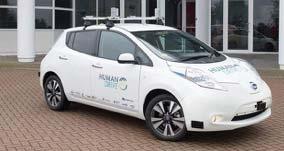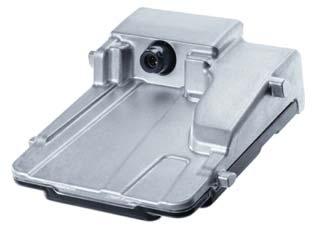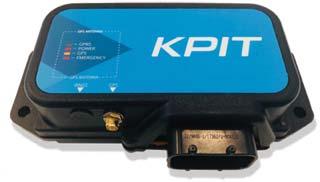
9 minute read
on Driven by DataConnected Cars: InnovaƟ
Last month at an event, Bosch showcased redundant braking for automated driving. Redundant funcƟ ons ensure that all safety-criƟ cal funcƟ ons conƟ nue in case of any failure in the system. For SAE levels 4 and 5, the redundancy becomes even more criƟ cal as the Ɵ me span increases without the driver in the loop.
Bosch’s soluƟ on for a fail-degraded brake system (steering system and E/E architecture) is the combinaƟ on of its electromechanical brake booster iBooster and ESC (Electronic Stability Control), also known as ESP (electronic stability program), systems. Both are independently capable of performing braking funcƟ ons for the vehicle in the rare case of a single failure.
Advertisement
A convenƟ onal brake system today comprises two actuators: a vacuum brake booster and ESC unit. The technological breakthrough of redundant braking was achieved by modifying one system element; the vacuum brake booster is replaced by an intelligent electro-mechanical booster, the iBooster.
The each actuator is now capable to decelerate the vehicle independent of the driver applying the brake pedal. Even if a failure occurs in the brake system, either actuator (iBooster or ESC) is able to avoid wheel lock-up by modulaƟ ng the brake pressure, which maintains the ability to steer during deceleraƟ on.

Australian CommunicaƟ ons and Media Authority has introduced new regulaƟ ons that will allow Australian road traffi c authoriƟ es to roll out intelligent transport systems (ITS) that enable vehicle-to-vehicle, vehicle-to-person or vehicle-toinfrastructure communicaƟ ons. Following industry consultaƟ on, the Australian CommunicaƟ ons and Media Authority introduced the RadiocommunicaƟ ons (Intelligent Transport Systems) Class Licence 2017, which will support the use of complying wireless technologies and devices. The regulaƟ ons allow the 5.9 GHz band to be used for ITS in Australia and are consistent with the ITS arrangements in major vehicle markets such as the United States and the European Union.
Harmonising Australia’s ITS arrangements with wider global developments means Australian motorists are more likely to enjoy the benefi ts of connected vehicles as they become available. According to FCC, Dedicated Short Range CommunicaƟ ons (DSRC) Service in the Intelligent TransportaƟ on Systems (ITS) Radio Service in the 5.850-5.925 GHz band (5.9 GHz band) involves vehicle-to-vehicle and vehicle-toinfrastructure communicaƟ ons, helping to protect the safety of the traveling public. It can save lives by warning drivers of an impending dangerous condiƟ on or event in Ɵ me to take correcƟ ve or evasive acƟ ons.
HORIBA MIRA announced its plans to develop safety guidance in the autonomous car project, ‘HumanDrive’. The HumanDrive project, led by Nissan’s European Technical Centre as part of Renault-Nissan Alliance research acƟ viƟ es, will culminate in the most complex journey yet aƩ empted across the UK without human driver input. to develop a vehicle that will emulate a natural human driving style, providing an enhanced experience for the occupants. To achieve this, the project will draw upon the experƟ se of a variety of organisaƟ ons, including Aimsun Ltd, Atkins, Cranfi eld University, Highways England, Hitachi, HORIBA MIRA, SBD AutomoƟ ve, Transport Systems Catapult and the University of Leeds.



DENSO has developed a standard vision sensor that detects pedestrians at night, cyclists, road signs, driving lanes and other road users. The sensor was featured in the 2018 Toyota Alphard and Vellfi re, which were released in January this year.
The vision sensor works in conjuncƟ on with a millimeter-wave radar sensor and allows automobiles to automaƟ cally acƟ vate emergency braking when obstacles are idenƟfi ed, helping reduce accidents and improve overall vehicle safety.
udelv, a California based company has launched its autonomous, last-mile delivery vehicle. The vehicle was also tested on the public roads where it traveled through a 2.5-mile loop with traffi c lights, lane changes, unsignalized leŌ turns and two delivery stops to deliver items to two nearby customers. In compliance with exisƟ ng California regulaƟ ons, the vehicle was supervised by a safety driver and in test mode.
NXP’s new CAN Transceiver family that secures CAN communications without cryptography
NXP Semiconductors announced a CAN transceiver family that off ers a seamless, effi cient soluƟ on for secure CAN communicaƟ ons without requiring soŌ ware or cryptography. With secure CAN transceivers, however, automakers can secure messages from the ECUs already used in the design, off ering a simpler, faster rollout of security than it would take to transiƟ on the exisƟ ng ECUs to secure ones.
A pure transceiver based soluƟ on for the CAN network developed by NXP off ers security without bandwidth overhead, delays and processor load. This approach complements crypto-based security soluƟ ons with an addiƟ onal layer in a Defense-in-Depth (DiD) concept, or as a standalone opƟ on. Another feature is the fl ooding prevenƟ on and rate limit control. Security soluƟ ons present in the market today protect CAN communicaƟ on with message authenƟ caƟ on code (MAC) based on cryptography and complex key management, but they require increased busload, message latency, or compuƟ ng power consumpƟ on. In addiƟ on to this, upgrading devices to support secure CAN messages is also not available, when the processors do not have suffi cient compuƟ ng power. However, with secure CAN transceivers, users can secure messages from devices already installed in systems by means of exchanging the transceiver, which makes it a reliable soluƟ on for increasingly complex cars.

The vehicle is built on a fully electric powertrain and features 18 secure cargo compartments with automaƟ c doors using a cloud-based proprietary technology that is shared between the vehicle, customers, and merchants. In its current confi guraƟ on, the vehicle can drive for up to 60 miles per cycle and can load up to 700 pounds of cargo.

High resolution automotive radar ICON
Source: Magna
Magna unveiled (Jan 2018) its high-resoluƟ on automoƟ ve radar ICON which incorporates advanced technology used by the U.S. military to provide precise detecƟ on, extensive range and high resiliency. The technology helps close the gap between level 3 and level 5 to reach full reliable autonomous driving.
With a range of more than 300 meters, Magna’s ICON RADAR conƟ nuously scans the environment in four dimensions (distance, height, depth and speed), which is 50 Ɵ mes faster than the Ɵ me it takes a human to blink an eye. With its compact size, ICON RADAR also allows greater fl exibility in exterior design and can be easily integrated into an automaker’s autonomous system or as part of Magna’s MAX4 autonomous vehicle plaƞ orm. It will thus enable faster decision making process in complex surroundings thereby ensuring safe mobility.
Ola working to develop safety systems capable of preventing accidents
The system being developed by the company would be able to prevent accidents by alerƟ ng the driver to take the correcƟ ve acƟ on in case it detects any possibility of an accident, like if the driver is drowsy or the car is likely to hit a pedestrian. The system would also be able to alert a central command, passenger’s family in case of an accident.

The company plans to employ automoƟ ve telemaƟ cs and use sensors like camera and radar to collect data. These devices would collect data that would be sent to a central command where it would be combined with other data like passenger’s booking history, Ɵ me, locaƟ on etc to be able to predict and prevent accidents. Earlier this month there were reports that the company is hiring technology professionals with autonomous or self-driving car coding skills. As of now the company is tesƟ ng these systems on a fl eet of Ola cabs, however, the business model and how the expenses of employing these services will be met has not been made clear Ɵ ll now. The report says the company aims to keep the expenses to the minimum and is in talks with some automakers on how these data can be collected and uƟ lized. It needs to be seen when and how these features are added in Ola Cabs.
KPIT launches ARAI certified AIS 140 compliant vehicle telematics device
KPIT has launched ARAI (AutomoƟ ve Research AssociaƟ on of India)-cerƟfi ed AIS- (AutomoƟ ve Industry Standard)-140 compliant vehicle telemaƟ cs and emergency buƩ on soluƟ on. According to KPIT, it is designed keeping in view the Indian operaƟ ng condiƟ ons and aligned to future AIS140 roadmap such as Vehicle Health Monitoring, CCTV Camera, Passenger InformaƟ on System etc. Salient Features of this AIS-140 Compliant Vehicle Tracking system are:

• Easy to install
• Real-Ɵ me vehicle updates
• Easy-to-integrate peripherals like voice box, LED Boards, etc.
• BaƩ ery backup up to 8-hour
MapmyIndia Smart Mobility Platform

MapmyIndia has unveiled Smart Mobility Plaƞ orm designed to address the emerging challenges of the AutomoƟ ve Industry for both personal and commercial customers. MSMP can be easily connected to the vehicle using mulƟ ple interfaces like SDL (smart device link). It becomes a central control point for the interacƟ on between the vehicle and the user. The newly created MapmyIndia Map App will off er users a single window access to features like navigaƟ on, tracking, streaming media services, driver feedback etc. on the device of their choice viz. vehicle AV, smartphone etc.
Motherson Group launches telematics product ‘Rollr’
Samvardhana Motherson Group has launched telemaƟ cs product ‘Rollr’, which provides informaƟ on on real-Ɵ me tracking, locaƟ on analyƟ cs and engine health. Rollr provides connected vehicle soluƟ ons from devices to applicaƟ ons, thereby providing users access to vehicle telemaƟ cs comprising real-Ɵ me tracking and locaƟ on analyƟ cs, engine health. It can also provide security alerts and driving behavior, along with providing regular reports summarising pre-set parameters. While Rollr Mini is perfect for families use as a track and trace soluƟ on, Rollr Fleet caters to fl eet owners with more than ten vehicles and enterprise Rollr is aimed at large businesses with over 200 vehicles.
Tata Motors testing driverless buses

Tata Motors is tesƟ ng driverless buses at its Pune campus. The company has developed a full-fl edged bus which is being tested on a fi xed route, without any human intervenƟ on, from the last two months. The bus uses the sensors placed at simulated bus stops to slow down or adjust its speed allowing the passengers to board and alight. At present the buses being tested at a lower speed of 10Kmph but as the plaƞ orm stabilizes, they would be tested at higher speeds and more realisƟ c road condiƟ ons.
Quick Takeaway
ŠKODA AUTO India launches a new version of its ‘MyŠKODA’ mobile app Ashok Leyland to work with Phinergy on electric vehicles Zoomcar set to raise $50 million from
Mahindra & Mahindra and Ford Nissan Motor plans to launch a low budget electric car in India Trak N Tell launches “Intelli Fleet”
Scania and Haylion Technologies join forces










